Iai Sword Standards: Practical Use and Cutting
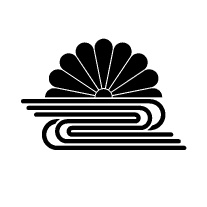
From: Nihon To Tameshigiri no Shinzui (The Essence of Japanese Sword Test Cutting)
By: Nakamura Taizaburo
Tokyo: Kodansha, 1980.
Keep in mind that there really is no standard size as swords should be tailored to the individual's body and personal likes. Generally, the sword length is measured in the following way: Stand naturally erect and hold the sword's handle just below the tsuba, allow your arm to hang comfortably along the side of your leg. Allowing the sword to rest point down, the tip of a correct length sword should barely touch the ground a few inches in front of the foot.

The prime example of a sword used for iai batto-do.
a. Monouchi width about 2.5 cm (1")
b. Base width about 3 cm (1 1/4")
c. Tang length about 21 cm (8 1/2")
d. Sori depth about 1.5 cm (5/8")
e. Monouchi (striking area)
f. Depth of hamon about 1/3-1/4 of the blade's width.
g. Handle length about 24 cm (9 1/2")
h. Blade length about 67-71cm (26 1/2 - 28")
Proper Grip (Te-no-uchi):
Regardless of your hand size, the tsuka (handle) should be only long enough to accommodate a two-finger gap between the trailing edge of the right hand and the leading edge of the left hand (see figure 2).
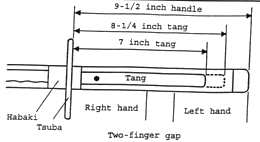
It is acceptable for just a bit of the kashira (pommel) to extend from the left fist; however, don't get in the habit of using a fist-to-fist baseball bat type of grip. This "baseball bat" grip reduces both the amount of positive control to the blade, and power in executing the cut. Be sure to put the palms of your hands along the top of the handle's ridge line. This position strengthens the grip and also increases the strength of the cut.
If your palms are placed along the flat of the handle, only the thumb knuckles overlap the handle ridge. This is a very weak grip and allows the sword to be easily dislodged. In addition, you may injure your knuckles from impact stress, as well as by the force generated by a solid object (sword) traveling through the air. This position also forces the muscles in your hand to work harder and tire more easily; increasing the risk of your losing control of the blade, or even sending the sword sailing across the dojo.
Chakin Shibori (wringing grip). While grasping the handle, exert a slight twisting action, as if to wring excess water from a dishrag. Twist both hands inward, the right hand in a counter-clockwise direction, the left hand clockwise for a correct grip.
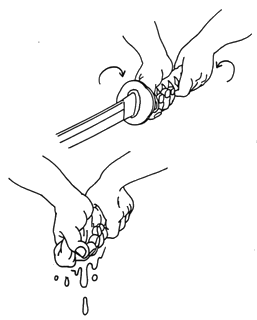
Short Nakago:
Generally, but not in all cases, koto and shinto era swords have a short nakago (tang). Some Showa-era swords have a short nakago because they were designed to be used with one hand so that a pistol could be used with the other. A sword with a short nakago should not be used for test-cutting; however, if this is all you have, then please do so with the following advice.
When the nakago is short (between 4 and 5 inches) then is the time to use a baseball bat grip for test-cutting to provide additional support to the cut (as in figure 4). This is the ONLY instance in which you should choke up on the handle, allowing an unsightly amount of tsuka to extend past the left hand.

If you try to use a correct grip, the torque created by the wringing action and the impact shock stress generated by cutting may cause a structural degradation of the handle where the nakago ends. This degradation may break the sword. (Fig. 5) I have done this while practicing kata with an older Showa-era sword that had the original handle.
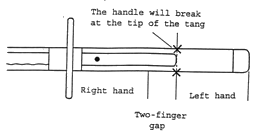
On this note, if you are using a sword with a handle over 20 years old, have the handle replaced.
Mekugi:
Swordsmanship is one martial art in which safety is of paramount importance. Always check the mekugi prior to practice, even if you are alone. Replace any mekugi that is thin, broken, or appears weak. Failure to do a safety check can lead to disaster. A 6th grade student was killed in Japan while he observed an iaido demonstration. The performer's blade was thrown from its handle into the audience because the mekugi had slipped from its housing. This terrible accident could have been prevented if the performer had checked his handle prior to the demonstration.
In the interest of safety, practitioners of Toyama Ryu and Nakamura Ryu use two retaining pins, as shown in Figure 6. The primary mekugi should be of bamboo, inserted from the right side of the handle; the hikae (reserve) mekugi should be manufactured of iron or steel and inserted from the left side.
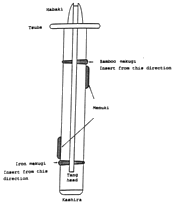
Bamboo is the preferred material for the primary mekugi because it is flexible; even if it breaks, the fibers are resilient enough to prevent the blade from being propelled across the room. The handle should be designed so that the mekugi can be inserted from only the side of the tsuka which is covered by the palm.
The hikae mekugi, the fail-safe, is usually iron and should have a rough enough edge to lock into the nakago. If the mekugi is smooth, create a firm fit by roughening the outside of the metal mekugi with a file, hacksaw, or wirecutters. The resultant "teeth" bite firmly into the soft steel of the nakago and prevent the metal mekugi from slipping out during training.
Fittings
The fuchi (support band) and kashira (pommel), like most components of a sword, are often an expression of the owner. One of the most prevalent styles today is the Higo style (fig. 7), named after the province of its adaptation (present-day Kumamoto). The Higo fittings differ from others in that the fuchi tapers slightly from the nakago ana (tang slot) to where it meets the handle; the topmost crest of the kashira gently slopes downward toward the butt of the handle, much like a well-worn hilt.

The Higo kashira has found a popular audience with today's iaido exponents because of its elegant style and its comfortable practicality: unlike other styles possessing a more linear construction, it does not cause blisters in the left palm. Higo fittings are well represented in Toyama Ryu and Nakamura Ryu dojo.
Menuki:
Menuki are the ornaments affixed to the handle, between the rayskin and the wrapping. They were originally decorations used to cover the sword retaining pins (mekugi); however, in later times they became practical in that when placed where the palm meets the handle, the resultant gap was filled. This "palm swell" created a more comfortable grip, quite similar to today's custom pistol grips which are ergonomically designed to "fill" the palm.
Since the tachi was worn slung from a belt with the cutting edge down, the right-hand menuki, when observed from the obverse (omote), was placed closer to the retaining pin. When the tachi-styled sword transitioned in the late 16th century to the uchigatana (worn edge-up, thrust through a sash), the convention remained of placing the omote menuki close to the retaining pin. This resulted in the menuki being on opposite sides of the palm. Practicality has been superceded by a strict adherence to format.
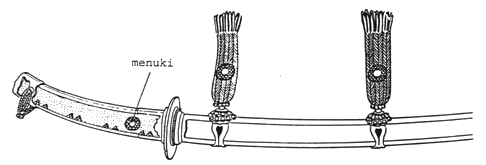
Few schools of swordsmanship retained the practical method of positioning the menuki. The one notable ancient style is the Yagyu Ryu; the modern styles which adopted this method are the Toyama Ryu and Nakamura Ryu.

Menuki placement on the handle as viewed from above:
A. (left) This illustrates a good placement of the left and right menuki as the handle is grasped from above. B. (center) This illustrates a good placement of the right mekugi when using only the right hand. The left mekugi may be centered on the handle, as it will have no relation to the grasp. (Actually, there is no restriction stating that the left mekugi must be placed lower.) C. (right) Edo period fittings (uchigatana mounting). Most swords are outfitted in this manner. This positioning is the least desired.
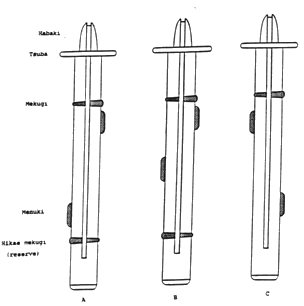
Tsuba:
The tsuba (hand guard) is essential in that it protects your right hand; however, the tsuba need not be overly large. As a matter of fact, if a deflection is properly executed, a tsuba is not at all necessary. However, we humans have a psychological reliance for the mere presence of a tsuba.
Because the tsuba is so easy to replace, many practitioners try to find original pieces or modern reproductions that match their own personality. In doing so, they often choose large tsuba, one with dimensions exceeding 3 1/4 inches. A large tsuba is undesirable because it interferes with proper sword handling techniques by applying pressure to the back of the right hand. If you have a rim impression on the back of your right hand after training, your tsuba is too large.
The preferred tsuba in Toyama Ryu and Nakamura Ryu is the small tsuba; an excellent example is the "Nakamura Hanjiro" tsuba. The predilection for the smaller tsuba may have its origin with the model 1934 shin gunto (new army sword) which had a regulation tsuba of approximately 2 x 3 inches --- the sword techniques of the Toyama Military Academy were specifically designed with this sword in mind.
Nakamura Hanjiro Tsuba
Nakamura Hanjiro was an army general and master of Jigen Ryu kenjutsu. In 1981 Nakamura Taizaburo sensei was a guest at an NHK television (equivalent to ABC or BBC) production given in honor of Nakamura Hanjiro. Afterwards, a descendent of Hanjiro presented Nakamura sensei with a copy of Hanjiro's tsuba, stating, "Your spirit is the very same as that of Nakamura Hanjiro."
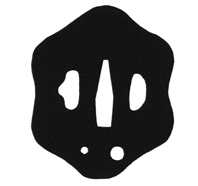
This tsuba, with its six gently undulating round lobes remains one of Nakamura sensei's favorites. It measures 2 1/2 x 3 inches and is devoid of artwork. There are openings on either side of the nakago ana (tang slot) for utility knives, and a set of udenuki ana (retention cord holes). The retention cord was used in battle much like the strap on a ski pole or a racquet ball racquet (fig. 12).
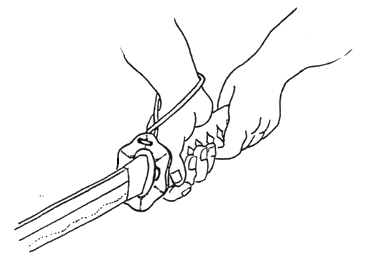
NOTES: In the measurements given, 1 shaku is roughly equivalent to 1 foot. 10 bu = 1 sun (about 1 inch); 10 sun = 1 shaku. Also text in parentheses are notes by the translator.
LENGTH:
(Note: A sword length is measured in a straight line from the munemachi to the kissaki. Regardless of how straight a sword is or how deeply curved it is, the straight line distance is its length.)
Sword blades transitioned to 2 shaku 3 sun (about 70 centimeters) because the Tokugawa government (ca. 1600-1867) standardized the measurement. Examples of swords being 2 shaku, and 2 shaku 5 sun exist; however, these were instances where a person's body height was extremely different from the average of the day. Also, the former Imperial Army and Navy military swords were standardized at 2 shaku 2 sun (about 67 centimeters).
Swords used in modern iaido range from 2 shaku 3 sun to 2 shaku 5 sun (about 70 cm. to 76 cm.) in length. Anything longer than that would be for an exceptionally large person. Using a sword longer than 2 shaku 5 sun for tameshigiri (test-cutting) is inadvisable because the body of the blade may be a bit weak due to the excessive length of the blade. The blade may bend or break when combined with the physical shock of striking an immovable object, incorrect blade angle, and an incorrect striking angle. The longer a blade is, the more likely it is to be weak.
I had the considerable opportunity to meet the great master Nakayama Hakudo (Hiromichi) sensei and was able to hear his insight about the length of a sword. Nakayama sensei said that subtracting 3 shaku (90 cm) from one's own height was a good rule-of-thumb; the resulting difference would be a good sword length. From my height of 5 shaku 4 sun (164 cm), I subtracted 3 shaku. Therefore, a good length for my sword would be 2 shaku 4 sun (73 cm). However, this length would only be good for practicing iai kata in empty space; it is just a bit too long for test-cutting. After World War Two I was presented with a koto sword which was 2 shaku 4 sun 5 bu (74 cm) in length and I used it for about five years. But once while test-cutting, my grip was not on the mark and I ended up bending the sword beyond repair.
The standard blade length for modern test-cutting is 2 shaku 3 sun 5 bu (71 cm); I recommend that students do not use swords exceeding this length.
WEIGHT:
A regular sword which is good to use will weigh from 1.1 kilograms up to 1.3 kg, including the handle and tsuba. If the sword is any heavier, the practitioner will have to use physical strength. It may appear all right while practicing iaido forms, but when cutting forcefully downward or executing chiburi (blood removal), the blade will often shake uncontrollably when brought to a halt. The root cause of many bad habits in swordsmanship is that the sword is too heavy. It is essential to use caution with a heavy sword.
SORI (CURVATURE):
(The sori is measured at the deepest portion between the imaginary " length"-line and the back of the blade.)
A sori of 5 bu (1.5 cm) is adequate for a sword of 2 shaku 3 sun (70 cm). Anything deeper or shallower is unsatisfactory for high class swordsmanship.
MIHABA (BLADE WIDTH):
The ideal blade width will be approximately 1 sun (3 cm) at the tsuba-moto (base of the hand guard), and about 8 bu (1.4 cm) at the monouchi ("sweet spot," about 1/3 of the blade measured from the point). The balance of a sword of these measurements will be good. As with the sori, anything more or anything less will be unsatisfactory for high class swordsmanship.
NAKAGO LENGTH:
The length of the nakago (tang) affects the balance of the sword; this becomes very important for the principles of high class swordsmanship.
Generally speaking, koto and shinto swords will have a nakago of approximately 5 sun (15 cm). The standard handle length is 8 sun (24 cm). In this case, if the nakago is too short when cutting through material, the handle can break where the butt of the nakago meets the handle [fig. 5]. If the handle is 8 sun, the nakago should be 7 sun. If you sufficiently place a long nakago in the handle, the balance of the sword will be in the handle. Moreover, in the opposite case, if the blade-weight is light, a short nakago will improve the balance of the sword.
In the case of a heavy blade having a short nakago, the balance can be corrected by placing lead inside the body of the handle near the pommel. The blade will feel lighter because the center of gravity was shifted.
HAMON DEPTH:
A hamon (temper line) depth of one-third to one-fourth of the blade width is adequate. When the hamon is gaudily too deep, the blade is generally brittle and will chip easily; also, the blade will break easily. Worse yet, when the blade is hard, its kireaji (ability to cut well) will not be very favorable.
MENUKI PLACEMENT:
Wrapping the menuki to the handle came about during the Muromachi period (1338-1573) when the fittings were generally in the handachi (half-tachi) style. (That is, although the sword was worn as a katana thrust through a sash with the cutting edge skyward, its fittings and hardware were tachi-style.)
The previous Imperial Army and Navy military swords were also outfitted in the handachi style, and the menuki were placed where the palms of the hand meet the handle. During the Edo period (1600-1867) the menuki were placed opposite that of the handachi, on the opposite side of the palm.
The menuki are the overall ornament for the handle; essentially, they are useless when placed in the Edo style. However, if the menuki are affixed in the handachi style, one's swordsmanship will become satisfactory. 90% of the swords used by today's iaido enthusiasts have the Edo style menuki placement.
GROOVE:
A sword with a groove will make a whistling sound when swung. Many high- ranking practitioners dislike swords with grooves; however, there are some high-ranking practitioners that like the groove. In the samurai period movies and plays, a whistling sound is dubbed in to appeal to the audience. Also, the novice believes that making the whistling sound while cutting shows good technique. This thought also prevails during iaido exhibitions. With the exception of experts, it is generally believed that an emitted sound is wonderful.
If a sword has a groove there is the chance that it will alert your opponent during the dark of night. This is not proper for high class swordsmanship, so the story goes. I have heard that a long time ago the term chi-nagare (blood flow) was used because the blood would flow down the groove as water flows down a ditch.
The presence of a groove has absolutely no relationship to whether the sword will cut well or not; however, it does have something to do with the weight and balance of the sword. The entire blade will be just a bit weaker with a groove, but dynamically speaking, it will also have more flexibility.
The overall form of a sword with a groove is gracefully elegant, and generally speaking, there are many people who like this style.
SHINOGI (RIDGE):
The height and pitch of the shinogi is relative to the blade's ability to cut well. Many factors affect a sword's sharpness or dullness, and differ according to the swordsmith. The most important aspect overall is the blade width; what is more related to this, and has become the problem, is the height of the shinogi.
A sword with a high shinogi will cut thick, hard material well; however, its penetration of soft material is poor. For example, when performing suemono giri (vertical cut) on horizontally stacked material such as rolls of rice straw, the sword's ability to cut well is reduced by half.
Compared with the previous example, a sword with a flat shinogi will cut soft material well; its penetration of horizontally stacked rolled straw will be good, and its sharpness will be satisfactory. However, if you make a mistake even while using the proper tenouchi (grip), the blade will bend.
If I may offer an example, a sword named "Seki no Magoro Kanemoto" was well known as the best cutting sword. It was constructed with a flat shinogi, and the way it easily cut through material was its special feature. Both "Dodanuki" and a shin-shinto "Mito" sword were known to be sharper than Kanemoto; but, when performing suemono giri (daigiri (cutting on a platform) ), the Kanemoto cut through five stacked layered rolls of rice straw while the others came to a halt in the third roll.
That was in the case of cutting on a platform: a sword with a raised shinogi will get stuck, which is a bad fault. The sharpness may be the same, but the proof is in the height difference of the shinogi. A blade with a high shinogi is suitable for actual combat as well, but in the case of platform cutting, a definite difference becomes clear.
In essence, a sword with a wide blade and flat shinogi will have perfect sharpness.
When cutting bamboo, the cutting ability of a sword with a high shinogi will not significantly change. Its flexibility will be strong, and is suitable for bamboo. On the other hand, a flat shinogi has no flexibility and is unsuitable for cutting bamboo. When one's hasuji or tenouchi are wrong, the blade will often bend.
In short, test cutting is similar to cooking. Different kitchen knives are used according to what is being prepared. A knife with a thick "back" will be used for hard vegetables and meat; a knife with a thin "back" will be used for soft items such as greens.
I have traveled the length and breadth of Japan not just to test the sharpness of swords, but to express my thoughts and experience in my special area of kireaji. I particularly wanted to write about the ideal sword for actual use; however, because this field is so broad, I have only presented an abridgment.
